Economics Case Study: Evaluation of a Small Business Performance
VerifiedAdded on 2022/08/13
|11
|1363
|8
Case Study
AI Summary
This case study analyzes the economic performance of a small business, focusing on key concepts like economic depreciation and price elasticity of demand. The analysis is divided into four tasks. Task 1 calculates accounting and economic costs and profits. Task 2 determines the price elasticity of demand based on changes in price and quantity. Task 3 examines how a price increase affects sales, and Task 4 evaluates whether the business earned normal or abnormal profit. The case study concludes that the product's demand is relatively inelastic, and the business generated an above-normal profit. The report includes calculations and explanations in the appendix, demonstrating how the business's financial data and market conditions impact its overall economic performance.

Running head: EVALUATION YOUR SMALL BUSINESS
Evaluation Your Small Business
Name of the Student
Name of the University
Student Number
Evaluation Your Small Business
Name of the Student
Name of the University
Student Number
Paraphrase This Document
Need a fresh take? Get an instant paraphrase of this document with our AI Paraphraser

1EVALUATION YOUR SMALL BUSINESS
Executive Summary
The business report deals with two of the important aspect of business evaluation. The
first is economic depreciation which captures extent to decline in market value of an asset due to
changing dynamics of an economy. This is a separate concept of accounting depreciation and is
crucial for business owner attempting to sell their productive assets. Another important concept
for the business is price elasticity of demand. The behavior of total revenue or sales give a price
change depends on elasticity of demand.
These two concepts are used to develop a case study analysis for the small business. The
entire evaluation is divided into four tasks. The first task computes different cost and profit of the
business. Task 2 is concerned with estimating price elasticity of demand for the product. Task 3
applies the concept of price elasticity of demand to describe changes in sales for a given change
in price. Finally, Task 4 analyzes whether the business had made a normal profit or not. The
report concludes that elasticity of demand for the product is relatively inelastic and the business
successfully made more than normal profit.
Executive Summary
The business report deals with two of the important aspect of business evaluation. The
first is economic depreciation which captures extent to decline in market value of an asset due to
changing dynamics of an economy. This is a separate concept of accounting depreciation and is
crucial for business owner attempting to sell their productive assets. Another important concept
for the business is price elasticity of demand. The behavior of total revenue or sales give a price
change depends on elasticity of demand.
These two concepts are used to develop a case study analysis for the small business. The
entire evaluation is divided into four tasks. The first task computes different cost and profit of the
business. Task 2 is concerned with estimating price elasticity of demand for the product. Task 3
applies the concept of price elasticity of demand to describe changes in sales for a given change
in price. Finally, Task 4 analyzes whether the business had made a normal profit or not. The
report concludes that elasticity of demand for the product is relatively inelastic and the business
successfully made more than normal profit.
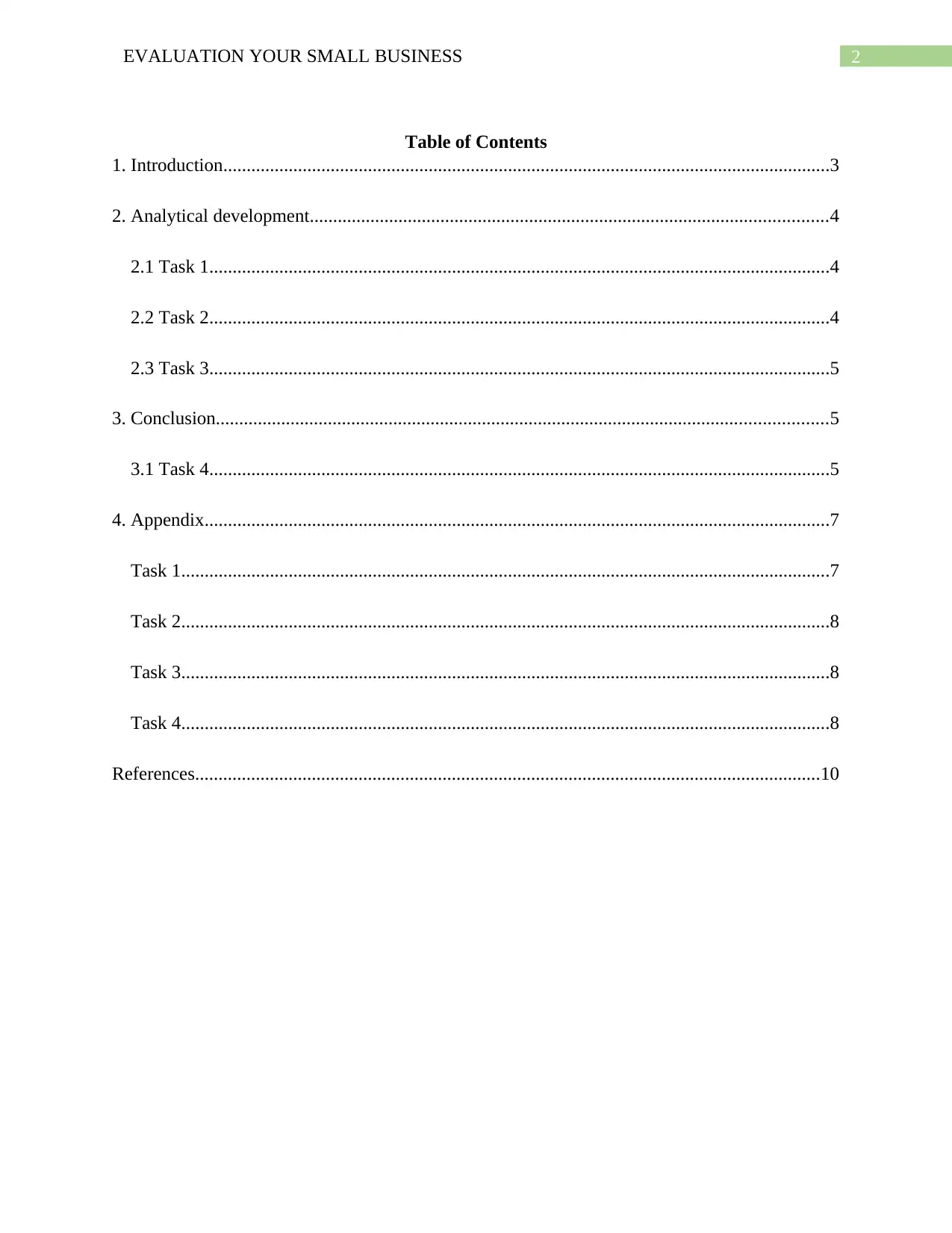
2EVALUATION YOUR SMALL BUSINESS
Table of Contents
1. Introduction..................................................................................................................................3
2. Analytical development...............................................................................................................4
2.1 Task 1.....................................................................................................................................4
2.2 Task 2.....................................................................................................................................4
2.3 Task 3.....................................................................................................................................5
3. Conclusion...................................................................................................................................5
3.1 Task 4.....................................................................................................................................5
4. Appendix......................................................................................................................................7
Task 1...........................................................................................................................................7
Task 2...........................................................................................................................................8
Task 3...........................................................................................................................................8
Task 4...........................................................................................................................................8
References......................................................................................................................................10
Table of Contents
1. Introduction..................................................................................................................................3
2. Analytical development...............................................................................................................4
2.1 Task 1.....................................................................................................................................4
2.2 Task 2.....................................................................................................................................4
2.3 Task 3.....................................................................................................................................5
3. Conclusion...................................................................................................................................5
3.1 Task 4.....................................................................................................................................5
4. Appendix......................................................................................................................................7
Task 1...........................................................................................................................................7
Task 2...........................................................................................................................................8
Task 3...........................................................................................................................................8
Task 4...........................................................................................................................................8
References......................................................................................................................................10
⊘ This is a preview!⊘
Do you want full access?
Subscribe today to unlock all pages.

Trusted by 1+ million students worldwide
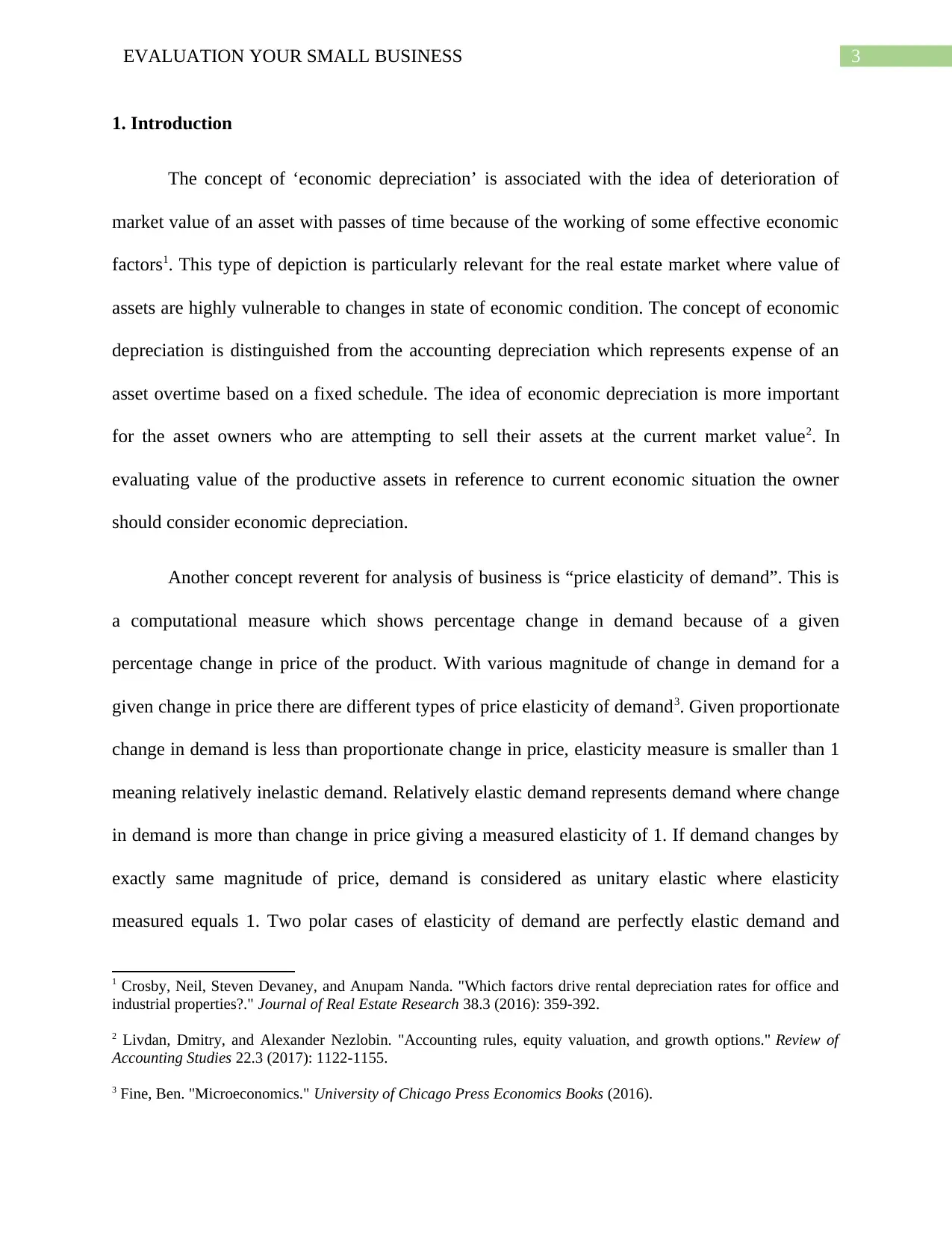
3EVALUATION YOUR SMALL BUSINESS
1. Introduction
The concept of ‘economic depreciation’ is associated with the idea of deterioration of
market value of an asset with passes of time because of the working of some effective economic
factors1. This type of depiction is particularly relevant for the real estate market where value of
assets are highly vulnerable to changes in state of economic condition. The concept of economic
depreciation is distinguished from the accounting depreciation which represents expense of an
asset overtime based on a fixed schedule. The idea of economic depreciation is more important
for the asset owners who are attempting to sell their assets at the current market value2. In
evaluating value of the productive assets in reference to current economic situation the owner
should consider economic depreciation.
Another concept reverent for analysis of business is “price elasticity of demand”. This is
a computational measure which shows percentage change in demand because of a given
percentage change in price of the product. With various magnitude of change in demand for a
given change in price there are different types of price elasticity of demand3. Given proportionate
change in demand is less than proportionate change in price, elasticity measure is smaller than 1
meaning relatively inelastic demand. Relatively elastic demand represents demand where change
in demand is more than change in price giving a measured elasticity of 1. If demand changes by
exactly same magnitude of price, demand is considered as unitary elastic where elasticity
measured equals 1. Two polar cases of elasticity of demand are perfectly elastic demand and
1 Crosby, Neil, Steven Devaney, and Anupam Nanda. "Which factors drive rental depreciation rates for office and
industrial properties?." Journal of Real Estate Research 38.3 (2016): 359-392.
2 Livdan, Dmitry, and Alexander Nezlobin. "Accounting rules, equity valuation, and growth options." Review of
Accounting Studies 22.3 (2017): 1122-1155.
3 Fine, Ben. "Microeconomics." University of Chicago Press Economics Books (2016).
1. Introduction
The concept of ‘economic depreciation’ is associated with the idea of deterioration of
market value of an asset with passes of time because of the working of some effective economic
factors1. This type of depiction is particularly relevant for the real estate market where value of
assets are highly vulnerable to changes in state of economic condition. The concept of economic
depreciation is distinguished from the accounting depreciation which represents expense of an
asset overtime based on a fixed schedule. The idea of economic depreciation is more important
for the asset owners who are attempting to sell their assets at the current market value2. In
evaluating value of the productive assets in reference to current economic situation the owner
should consider economic depreciation.
Another concept reverent for analysis of business is “price elasticity of demand”. This is
a computational measure which shows percentage change in demand because of a given
percentage change in price of the product. With various magnitude of change in demand for a
given change in price there are different types of price elasticity of demand3. Given proportionate
change in demand is less than proportionate change in price, elasticity measure is smaller than 1
meaning relatively inelastic demand. Relatively elastic demand represents demand where change
in demand is more than change in price giving a measured elasticity of 1. If demand changes by
exactly same magnitude of price, demand is considered as unitary elastic where elasticity
measured equals 1. Two polar cases of elasticity of demand are perfectly elastic demand and
1 Crosby, Neil, Steven Devaney, and Anupam Nanda. "Which factors drive rental depreciation rates for office and
industrial properties?." Journal of Real Estate Research 38.3 (2016): 359-392.
2 Livdan, Dmitry, and Alexander Nezlobin. "Accounting rules, equity valuation, and growth options." Review of
Accounting Studies 22.3 (2017): 1122-1155.
3 Fine, Ben. "Microeconomics." University of Chicago Press Economics Books (2016).
Paraphrase This Document
Need a fresh take? Get an instant paraphrase of this document with our AI Paraphraser
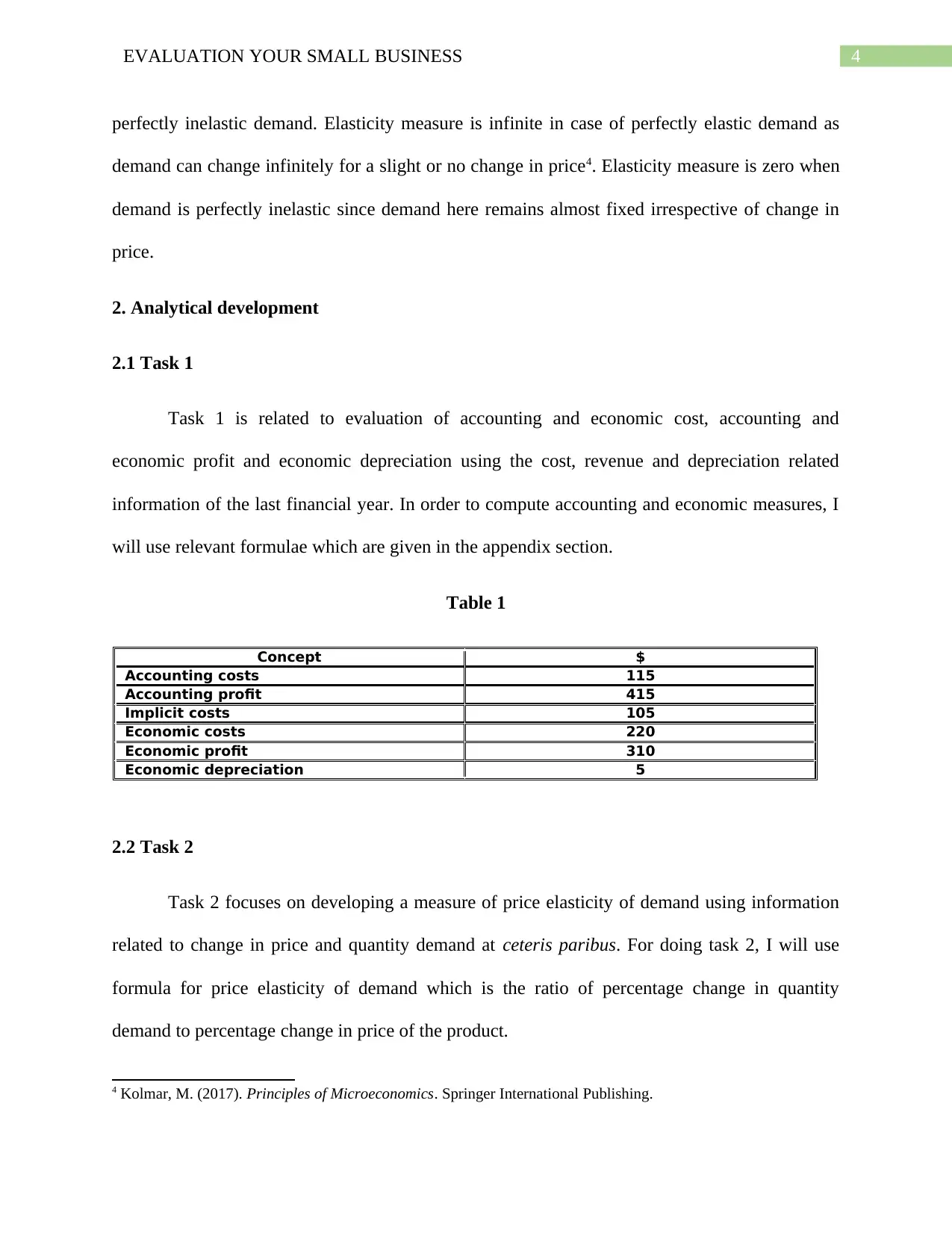
4EVALUATION YOUR SMALL BUSINESS
perfectly inelastic demand. Elasticity measure is infinite in case of perfectly elastic demand as
demand can change infinitely for a slight or no change in price4. Elasticity measure is zero when
demand is perfectly inelastic since demand here remains almost fixed irrespective of change in
price.
2. Analytical development
2.1 Task 1
Task 1 is related to evaluation of accounting and economic cost, accounting and
economic profit and economic depreciation using the cost, revenue and depreciation related
information of the last financial year. In order to compute accounting and economic measures, I
will use relevant formulae which are given in the appendix section.
Table 1
Concept $
Accounting costs 115
Accounting profit 415
Implicit costs 105
Economic costs 220
Economic profit 310
Economic depreciation 5
2.2 Task 2
Task 2 focuses on developing a measure of price elasticity of demand using information
related to change in price and quantity demand at ceteris paribus. For doing task 2, I will use
formula for price elasticity of demand which is the ratio of percentage change in quantity
demand to percentage change in price of the product.
4 Kolmar, M. (2017). Principles of Microeconomics. Springer International Publishing.
perfectly inelastic demand. Elasticity measure is infinite in case of perfectly elastic demand as
demand can change infinitely for a slight or no change in price4. Elasticity measure is zero when
demand is perfectly inelastic since demand here remains almost fixed irrespective of change in
price.
2. Analytical development
2.1 Task 1
Task 1 is related to evaluation of accounting and economic cost, accounting and
economic profit and economic depreciation using the cost, revenue and depreciation related
information of the last financial year. In order to compute accounting and economic measures, I
will use relevant formulae which are given in the appendix section.
Table 1
Concept $
Accounting costs 115
Accounting profit 415
Implicit costs 105
Economic costs 220
Economic profit 310
Economic depreciation 5
2.2 Task 2
Task 2 focuses on developing a measure of price elasticity of demand using information
related to change in price and quantity demand at ceteris paribus. For doing task 2, I will use
formula for price elasticity of demand which is the ratio of percentage change in quantity
demand to percentage change in price of the product.
4 Kolmar, M. (2017). Principles of Microeconomics. Springer International Publishing.
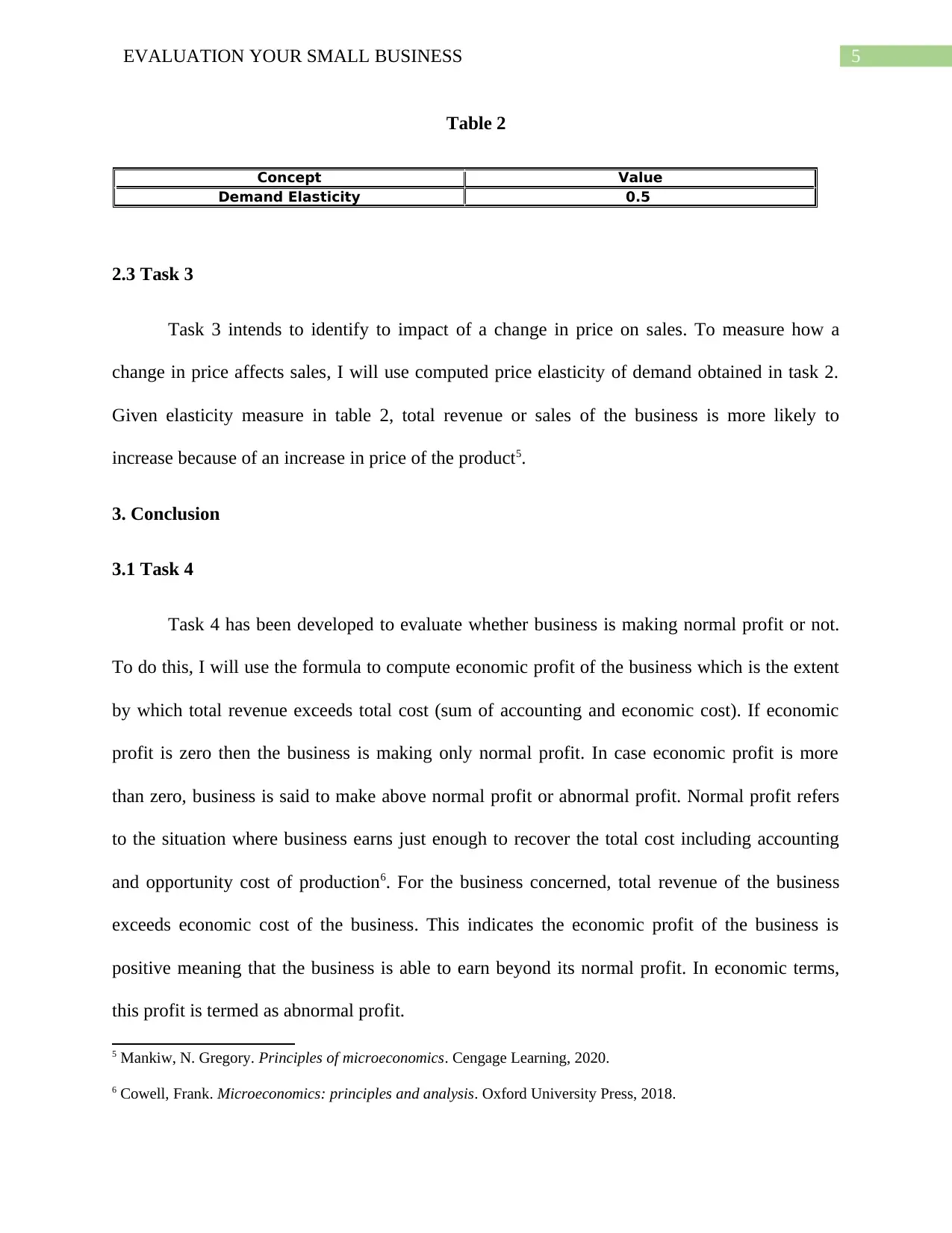
5EVALUATION YOUR SMALL BUSINESS
Table 2
Concept Value
Demand Elasticity 0.5
2.3 Task 3
Task 3 intends to identify to impact of a change in price on sales. To measure how a
change in price affects sales, I will use computed price elasticity of demand obtained in task 2.
Given elasticity measure in table 2, total revenue or sales of the business is more likely to
increase because of an increase in price of the product5.
3. Conclusion
3.1 Task 4
Task 4 has been developed to evaluate whether business is making normal profit or not.
To do this, I will use the formula to compute economic profit of the business which is the extent
by which total revenue exceeds total cost (sum of accounting and economic cost). If economic
profit is zero then the business is making only normal profit. In case economic profit is more
than zero, business is said to make above normal profit or abnormal profit. Normal profit refers
to the situation where business earns just enough to recover the total cost including accounting
and opportunity cost of production6. For the business concerned, total revenue of the business
exceeds economic cost of the business. This indicates the economic profit of the business is
positive meaning that the business is able to earn beyond its normal profit. In economic terms,
this profit is termed as abnormal profit.
5 Mankiw, N. Gregory. Principles of microeconomics. Cengage Learning, 2020.
6 Cowell, Frank. Microeconomics: principles and analysis. Oxford University Press, 2018.
Table 2
Concept Value
Demand Elasticity 0.5
2.3 Task 3
Task 3 intends to identify to impact of a change in price on sales. To measure how a
change in price affects sales, I will use computed price elasticity of demand obtained in task 2.
Given elasticity measure in table 2, total revenue or sales of the business is more likely to
increase because of an increase in price of the product5.
3. Conclusion
3.1 Task 4
Task 4 has been developed to evaluate whether business is making normal profit or not.
To do this, I will use the formula to compute economic profit of the business which is the extent
by which total revenue exceeds total cost (sum of accounting and economic cost). If economic
profit is zero then the business is making only normal profit. In case economic profit is more
than zero, business is said to make above normal profit or abnormal profit. Normal profit refers
to the situation where business earns just enough to recover the total cost including accounting
and opportunity cost of production6. For the business concerned, total revenue of the business
exceeds economic cost of the business. This indicates the economic profit of the business is
positive meaning that the business is able to earn beyond its normal profit. In economic terms,
this profit is termed as abnormal profit.
5 Mankiw, N. Gregory. Principles of microeconomics. Cengage Learning, 2020.
6 Cowell, Frank. Microeconomics: principles and analysis. Oxford University Press, 2018.
⊘ This is a preview!⊘
Do you want full access?
Subscribe today to unlock all pages.

Trusted by 1+ million students worldwide

6EVALUATION YOUR SMALL BUSINESS
Paraphrase This Document
Need a fresh take? Get an instant paraphrase of this document with our AI Paraphraser
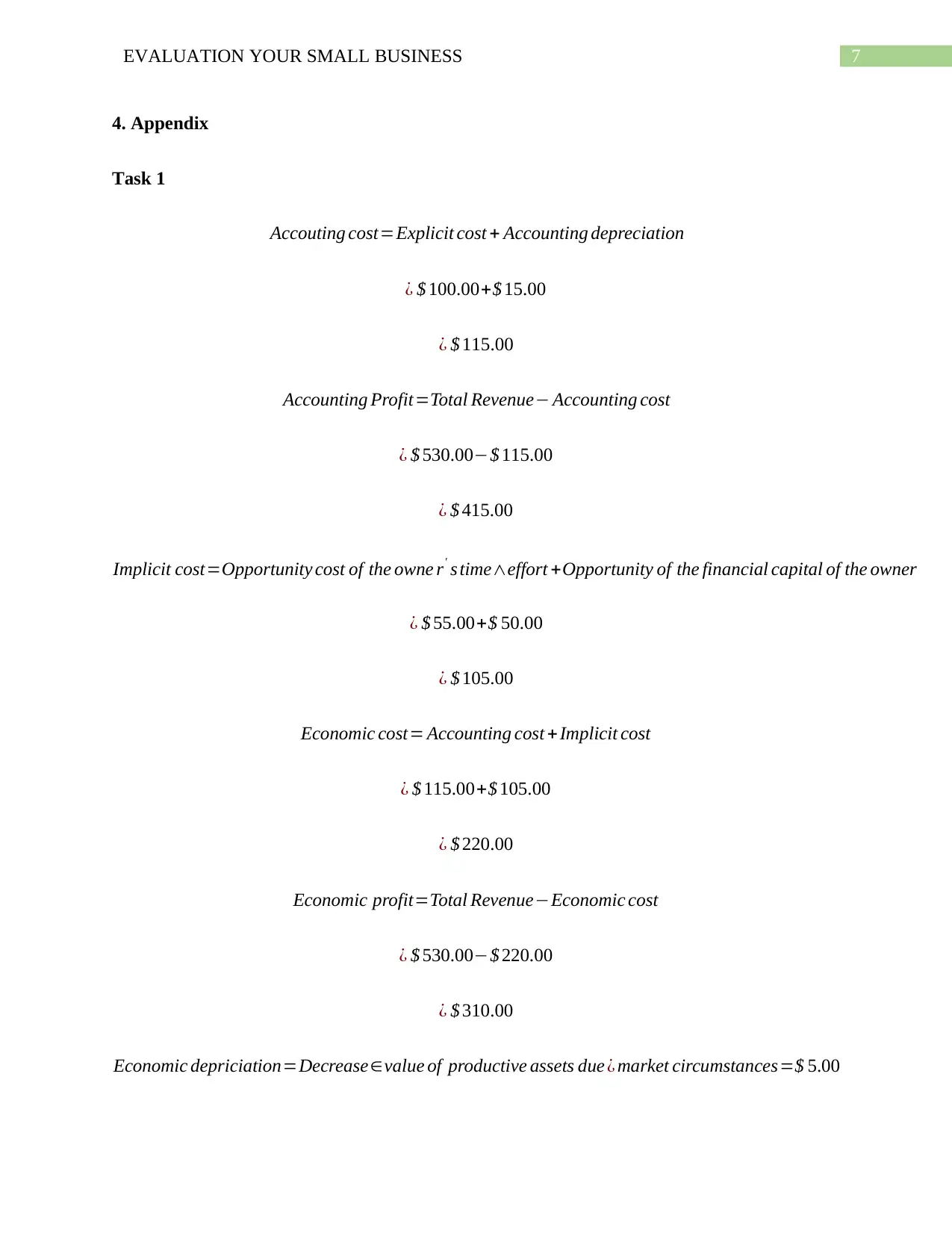
7EVALUATION YOUR SMALL BUSINESS
4. Appendix
Task 1
Accouting cost=Explicit cost + Accounting depreciation
¿ $ 100.00+$ 15.00
¿ $ 115.00
Accounting Profit=Total Revenue− Accounting cost
¿ $ 530.00−$ 115.00
¿ $ 415.00
Implicit cost=Opportunity cost of the owne r' s time∧effort +Opportunity of the financial capital of the owner
¿ $ 55.00+$ 50.00
¿ $ 105.00
Economic cost= Accounting cost +Implicit cost
¿ $ 115.00+$ 105.00
¿ $ 220.00
Economic profit=Total Revenue−Economic cost
¿ $ 530.00−$ 220.00
¿ $ 310.00
Economic depriciation=Decrease∈value of productive assets due ¿ market circumstances=$ 5.00
4. Appendix
Task 1
Accouting cost=Explicit cost + Accounting depreciation
¿ $ 100.00+$ 15.00
¿ $ 115.00
Accounting Profit=Total Revenue− Accounting cost
¿ $ 530.00−$ 115.00
¿ $ 415.00
Implicit cost=Opportunity cost of the owne r' s time∧effort +Opportunity of the financial capital of the owner
¿ $ 55.00+$ 50.00
¿ $ 105.00
Economic cost= Accounting cost +Implicit cost
¿ $ 115.00+$ 105.00
¿ $ 220.00
Economic profit=Total Revenue−Economic cost
¿ $ 530.00−$ 220.00
¿ $ 310.00
Economic depriciation=Decrease∈value of productive assets due ¿ market circumstances=$ 5.00
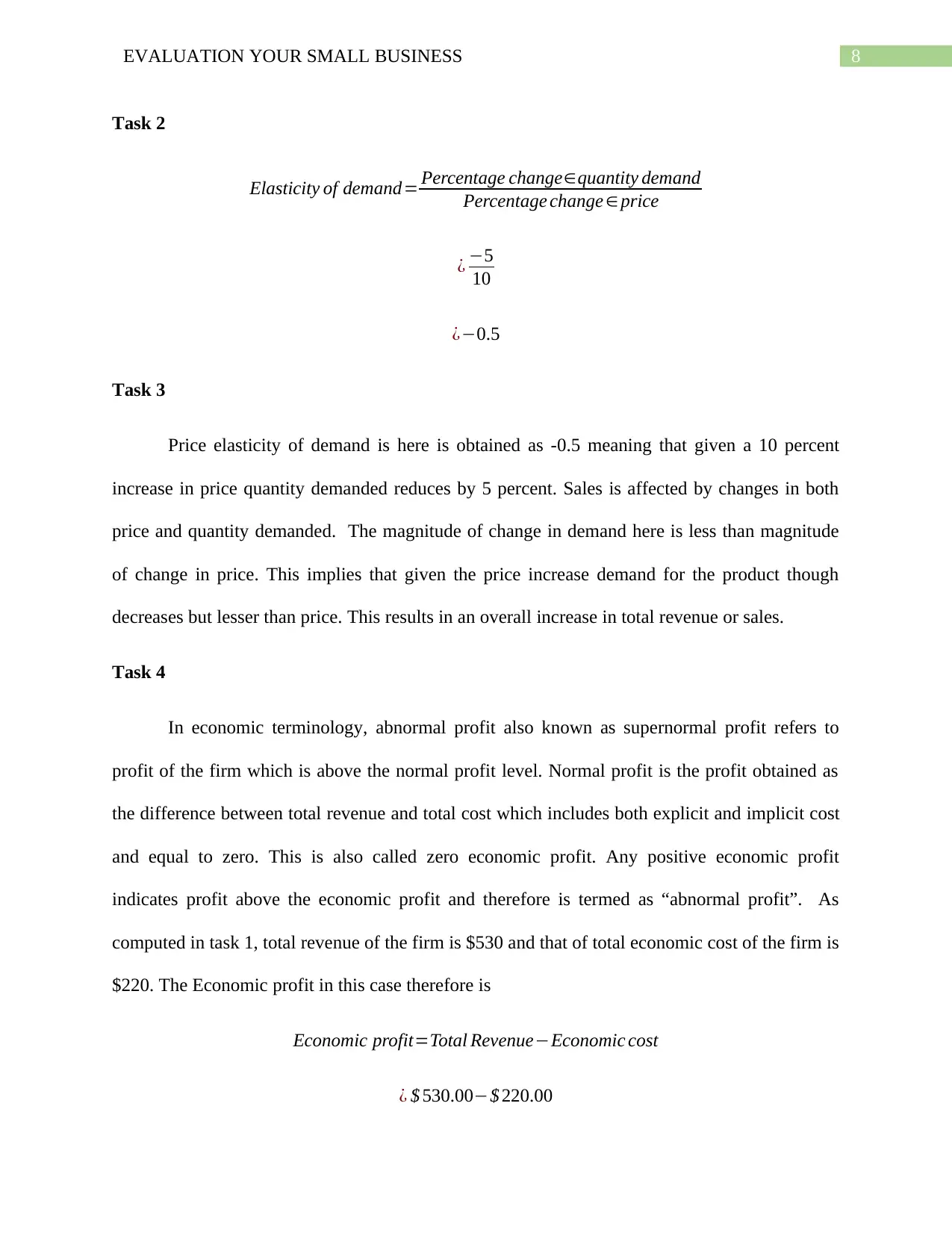
8EVALUATION YOUR SMALL BUSINESS
Task 2
Elasticity of demand= Percentage change∈quantity demand
Percentage change ∈price
¿ −5
10
¿−0.5
Task 3
Price elasticity of demand is here is obtained as -0.5 meaning that given a 10 percent
increase in price quantity demanded reduces by 5 percent. Sales is affected by changes in both
price and quantity demanded. The magnitude of change in demand here is less than magnitude
of change in price. This implies that given the price increase demand for the product though
decreases but lesser than price. This results in an overall increase in total revenue or sales.
Task 4
In economic terminology, abnormal profit also known as supernormal profit refers to
profit of the firm which is above the normal profit level. Normal profit is the profit obtained as
the difference between total revenue and total cost which includes both explicit and implicit cost
and equal to zero. This is also called zero economic profit. Any positive economic profit
indicates profit above the economic profit and therefore is termed as “abnormal profit”. As
computed in task 1, total revenue of the firm is $530 and that of total economic cost of the firm is
$220. The Economic profit in this case therefore is
Economic profit=Total Revenue−Economic cost
¿ $ 530.00−$ 220.00
Task 2
Elasticity of demand= Percentage change∈quantity demand
Percentage change ∈price
¿ −5
10
¿−0.5
Task 3
Price elasticity of demand is here is obtained as -0.5 meaning that given a 10 percent
increase in price quantity demanded reduces by 5 percent. Sales is affected by changes in both
price and quantity demanded. The magnitude of change in demand here is less than magnitude
of change in price. This implies that given the price increase demand for the product though
decreases but lesser than price. This results in an overall increase in total revenue or sales.
Task 4
In economic terminology, abnormal profit also known as supernormal profit refers to
profit of the firm which is above the normal profit level. Normal profit is the profit obtained as
the difference between total revenue and total cost which includes both explicit and implicit cost
and equal to zero. This is also called zero economic profit. Any positive economic profit
indicates profit above the economic profit and therefore is termed as “abnormal profit”. As
computed in task 1, total revenue of the firm is $530 and that of total economic cost of the firm is
$220. The Economic profit in this case therefore is
Economic profit=Total Revenue−Economic cost
¿ $ 530.00−$ 220.00
⊘ This is a preview!⊘
Do you want full access?
Subscribe today to unlock all pages.

Trusted by 1+ million students worldwide
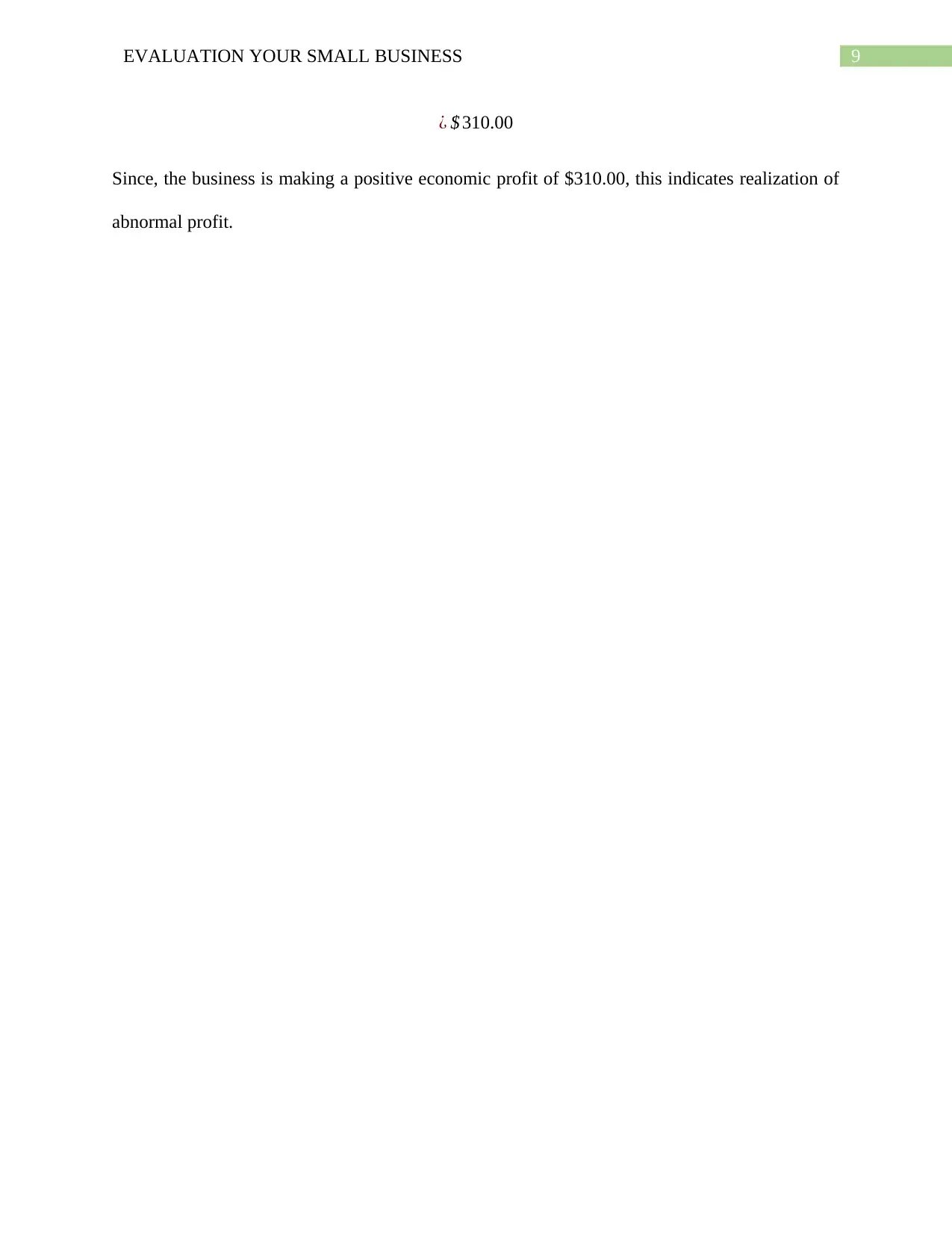
9EVALUATION YOUR SMALL BUSINESS
¿ $ 310.00
Since, the business is making a positive economic profit of $310.00, this indicates realization of
abnormal profit.
¿ $ 310.00
Since, the business is making a positive economic profit of $310.00, this indicates realization of
abnormal profit.
Paraphrase This Document
Need a fresh take? Get an instant paraphrase of this document with our AI Paraphraser
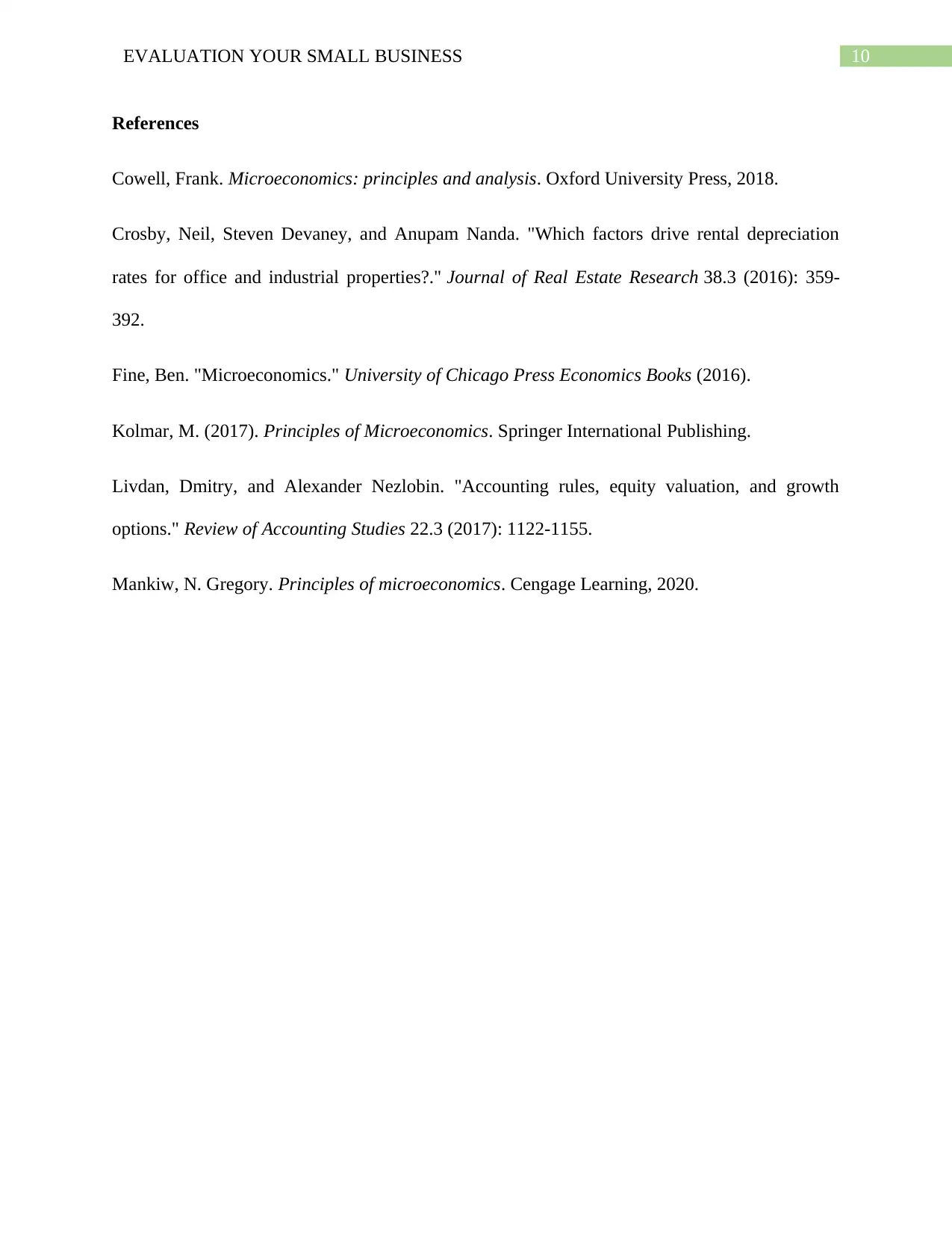
10EVALUATION YOUR SMALL BUSINESS
References
Cowell, Frank. Microeconomics: principles and analysis. Oxford University Press, 2018.
Crosby, Neil, Steven Devaney, and Anupam Nanda. "Which factors drive rental depreciation
rates for office and industrial properties?." Journal of Real Estate Research 38.3 (2016): 359-
392.
Fine, Ben. "Microeconomics." University of Chicago Press Economics Books (2016).
Kolmar, M. (2017). Principles of Microeconomics. Springer International Publishing.
Livdan, Dmitry, and Alexander Nezlobin. "Accounting rules, equity valuation, and growth
options." Review of Accounting Studies 22.3 (2017): 1122-1155.
Mankiw, N. Gregory. Principles of microeconomics. Cengage Learning, 2020.
References
Cowell, Frank. Microeconomics: principles and analysis. Oxford University Press, 2018.
Crosby, Neil, Steven Devaney, and Anupam Nanda. "Which factors drive rental depreciation
rates for office and industrial properties?." Journal of Real Estate Research 38.3 (2016): 359-
392.
Fine, Ben. "Microeconomics." University of Chicago Press Economics Books (2016).
Kolmar, M. (2017). Principles of Microeconomics. Springer International Publishing.
Livdan, Dmitry, and Alexander Nezlobin. "Accounting rules, equity valuation, and growth
options." Review of Accounting Studies 22.3 (2017): 1122-1155.
Mankiw, N. Gregory. Principles of microeconomics. Cengage Learning, 2020.
1 out of 11